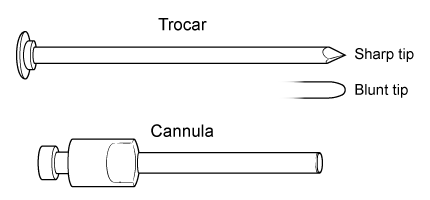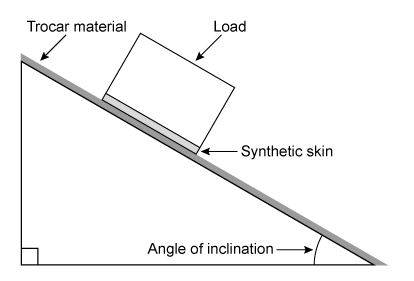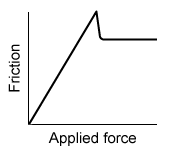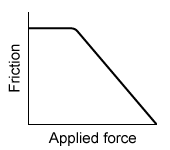Passage
Laparoscopy is a minimally invasive surgical procedure where small surgical instruments are inserted into the body through cannulas (hollow tubes 0.5 to 1.0 cm in diameter) . A cannula is inserted into the skin while sleeved around a trocar (Figure 1) . The skin incision can be made directly with a sharp-tipped trocar as it is being inserted with the cannula. If a blunt-tipped trocar is used, the incision is made beforehand with a surgical blade. After insertion, the trocar is removed, leaving the cannula as an access point for laparoscopic procedures.
 Figure 1 Cannula, trocar, and two types of tipsLow-friction trocars increase surgical precision and reduce postoperative scarring. Friction between the skin and trocar tip is tested with synthetic skin and a stationary ramp whose surface is made of the same material as the trocar. For testing, the synthetic skin is pressed against the ramp's surface by a load, weighted to allow the skin to slide down at a constant speed (Figure 2) . In this setup, the weight of the synthetic skin layer is negligible.
Figure 1 Cannula, trocar, and two types of tipsLow-friction trocars increase surgical precision and reduce postoperative scarring. Friction between the skin and trocar tip is tested with synthetic skin and a stationary ramp whose surface is made of the same material as the trocar. For testing, the synthetic skin is pressed against the ramp's surface by a load, weighted to allow the skin to slide down at a constant speed (Figure 2) . In this setup, the weight of the synthetic skin layer is negligible.
 Figure 2 Experimental setup to test the friction between trocar and skin
Figure 2 Experimental setup to test the friction between trocar and skin
Adapted from W. Firme-Gustavo et al., (C) 2015 Society of Laparoendoscopic Surgeons.
-To remove the cannula at the end of a laparoscopy, the surgeon pulls on the cannula with increasing force. How does the frictional force vary with the applied pulling force before and after the cannula begins to slide?
A) 
B) 
C) 
D) 
Correct Answer:
Verified
Q81: Passage
Laparoscopy is a minimally invasive surgical procedure
Q82: Passage
Laparoscopy is a minimally invasive surgical procedure
Q83: Passage
Cable theory is a mathematical model used
Q84: Passage
Laparoscopy is a minimally invasive surgical procedure
Q85: Passage
Sound waves propagate through many conducting structures
Q87: Passage
Cable theory is a mathematical model used
Q88: Passage
Cable theory is a mathematical model used
Q89: Passage
Hydrostatic weighing is a technique used to
Q90: Passage
Hydrostatic weighing is a technique used to
Q91: Passage
Sound waves propagate through many conducting structures
Unlock this Answer For Free Now!
View this answer and more for free by performing one of the following actions

Scan the QR code to install the App and get 2 free unlocks

Unlock quizzes for free by uploading documents